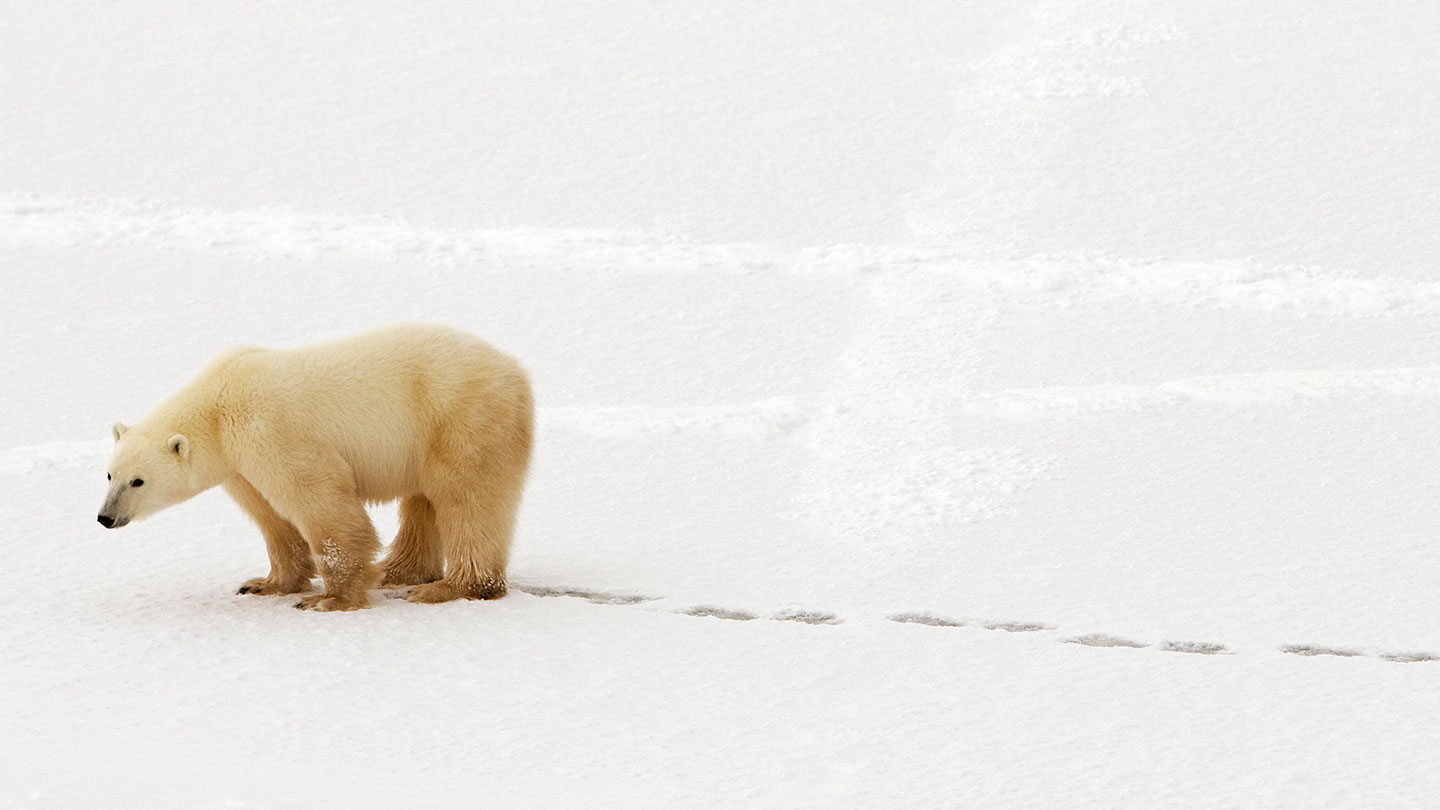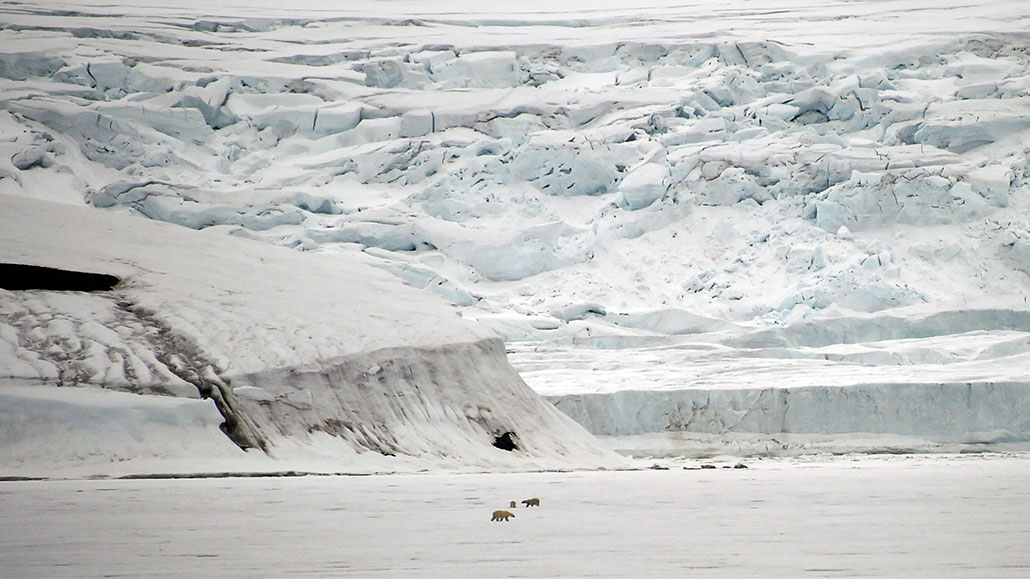Paw-print DNA lets scientists track out-of-sight polar bears
This environmental DNA can aid in conserving species that are hard or dangerous to observe

A polar bear walks through snow outside Churchill, Manitoba, Canada. With each step, it leaves behind telltale bits of its DNA. Researchers can later use this DNA, research now shows, to identify the individual and details of how it’s using its environment.
PAUL J. RICHARDS/AFP/Getty Images Plus
Paw prints left in the snow by polar bears are now revealing clues to their identity, sex and Arctic treks. Even without seeing an animal, researchers can tell which individual left a print, based on the DNA it shed with each step.
These genetic traces are known as environmental DNA, or eDNA. The skin cells, poop and pee that animals shed can all host eDNA, notes Ryan Kelly. He directs the eDNA Collaborative at the University of Washington in Seattle. Studying this “eDNA is relatively new,” he says, “and allows us to see the world in a whole new way.”
Animals leave traces of DNA in the soil and air. Aquatic species can leave similar “fingerprints” of their presence in water. Biologists study this eDNA much as crime-scene detectives use human DNA to identify potential suspects.
Before eDNA, studying polar bears was very dangerous and time-consuming, says Elisabeth Kruger in Anchorage, Alaska. She’s the Arctic wildlife manager for the World Wildlife Fund and an author of a new study.
In the past, she notes, a biologist would scout “a fairly small area of [a polar-bear] population flying around in helicopters.” Then they’d swoop down to dart an animal they wanted to study. The dart would deliver a tranquilizer to make the bear drowsy.
Once the bear was knocked out, the scientists could land to measure its weight and length. They’d also take blood and tissue samples. Sometimes they’d even fit the polar bear with a tracking collar. Such hands-on analysis is “very useful,” Kruger says, “but it’s also really invasive.” And, it’s “really expensive.”
It’s hardly quick, either. Scientists might fly around for hours just to find one bear. And the main way they spotted animals — even from helicopters — was to look for paw prints in the snow.
But now, her team has found, no one has to make contact with the bears. Once tracks are spotted, someone can simply scoop up a bit of the snow. It provides the DNA sample. “You never even have to see the polar bear,” Kruger says. What’s more, she adds, “the polar bear doesn’t have to see you. It’s completely noninvasive.” And that means less stress for the bears — and the biologists.
Kruger’s team shared new analysis of paw-print eDNA on December 4, 2023. It appeared in Frontiers of Conservation Science.

The type of DNA matters
Blood and tissue samples can identify not only individual polar bears, but also their sex. So can eDNA. Those genetic residues also are easier — and safer — to collect. That means nonscientists who live in the Arctic can help collect samples. That could lead to getting information from more bears.
Shannon Barber-Meyer is a wildlife biologist whose past work has focused on wolves. For her, identifying individuals “is the most exciting [part].” She’s studied eDNA from wolf tracks in the snow. Past genetic studies of mammals that live in the snow, such as wolves and lynxes, have tended to find and use DNA from a cell’s mitochondria. These are the energy center of cells. Such mitochondrial DNA can tell different species apart, but can’t identify individuals. That’s because the same mitochondrial DNA is shared by all relatives that share a common female ancestor.
The new polar bear study analyzed something different: DNA from a cell’s nucleus. This nuclear DNA serves as the blueprint for an individual’s particular genes. As such, this type of eDNA is like a fingerprint. It is unique and can identify an individual and how it differs from any other.
In the new study, researchers analyzed eDNA from 21 snow prints of wild polar bears, 26 prints from wild Eurasian lynxes and one from a snow leopard. From bear prints, they could pick out specific bears and their sex.
Such genetic material can sometimes be extracted from feces. But DNA does not always hold up well in poop. In one study in Mongolia, for instance, more than half of what apparently had been snow-leopard feces “were misidentified as red fox,” the researchers note. Because the snow acts like a refrigerator, it now appears to keep nuclear DNA fresher for a longer time.
Of course, the best genetic analyses tend to come from samples of the animals’ tissues. However, the researchers note, “the abundance and relative ease with which hair and tracks can be encountered make them useful” as a way to get low-cost data. That’s especially true for rare, dangerous or hard-to-find animals.
Polar bears rely upon the sea ice for camouflage, to hunt and to travel. Climate change is melting the sea ice faster than it can form. This is bad news for the polar bears that depend on it.
There are 19 subpopulations of polar bears in the Arctic. But little is known about how they live, Kruger says. Using eDNA, she hopes to learn more about where they live and what people might do to help protect them.
Do you have a science question? We can help!
Submit your question here, and we might answer it an upcoming issue of Science News Explores







